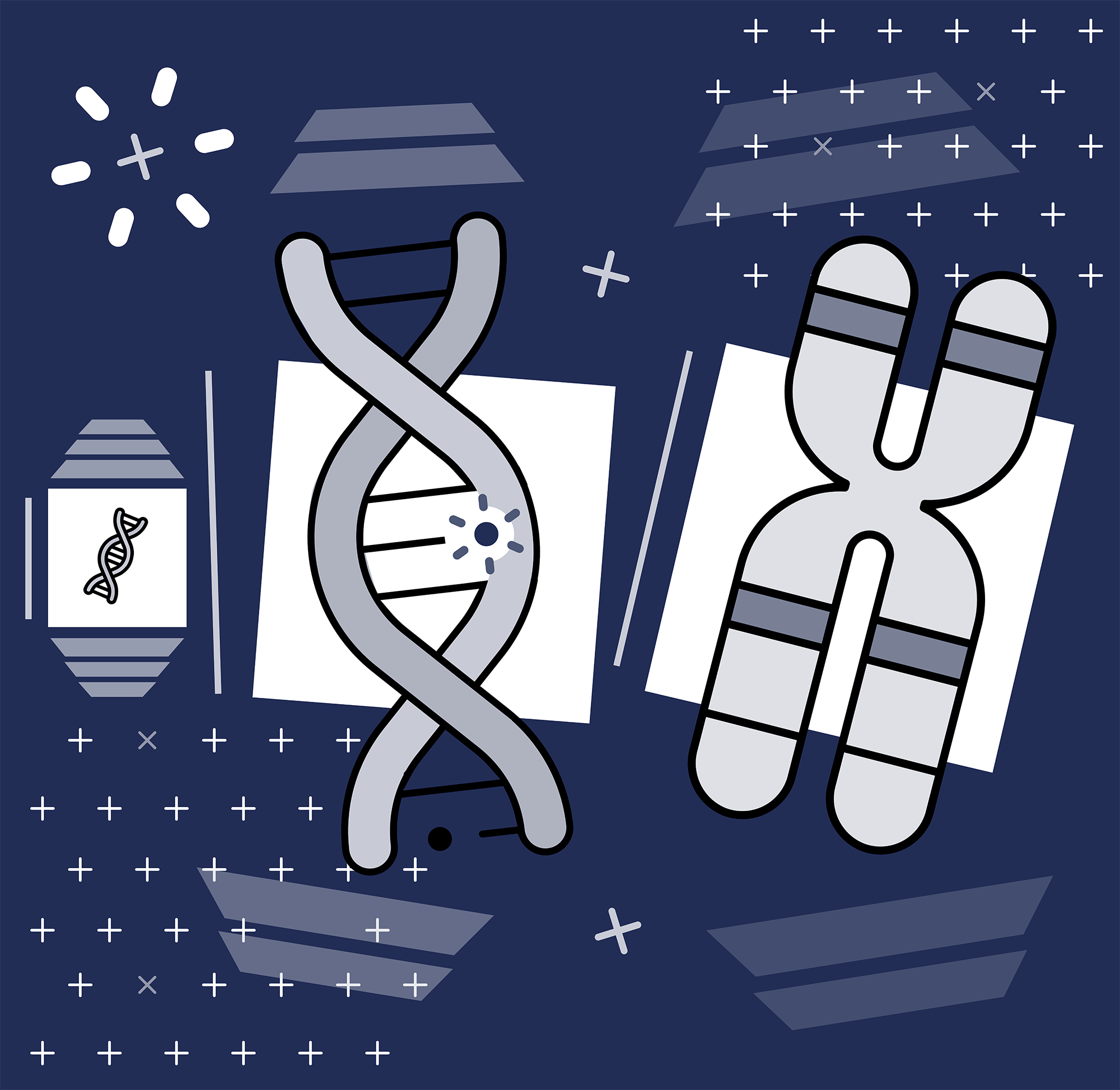Genes have names like RP1, RDH12, ABCA4 and PROM1, which usually give information about the protein they produce. You have two copies of each gene, one copy from your mother and one from your father.
Variation between different people’s copies of a particular gene is completely normal – it’s what makes us all unique and enables us to evolve. However, significant changes are sometimes present that make the instructions provided by the gene incorrect or unreadable, resulting in a faulty protein and ultimately causing problems such as inherited sight loss. We sometimes refer to these changes as mutations, and once they occur they can be passed down through the generations. See Inheritance patterns.
If we think of the entire human genetic code as a library, then genes are like individual books. The content of the books is spelled out in a four-letter chemical code held within a special molecule called DNA.
Each gene provides our cells with the instructions for building a particular protein, which are the building blocks of our bodies; they control our growth and perform a huge variety of other roles. The genes have names like RP1, RDH12, ABCA4 and PROM1, which normally stand for something long and complicated describing the function of the protein they code for. For example, RDH12 stands for retinol dehydrogenase 12, an important substance that helps retinal cells convert light into a nerve signal to the brain.
There are approximately 25,000 genes in the human genome library, arranged on 46 “shelves” – these are the chromosomes, which we sometimes see in microscopy photographs arranged as pairs of strands, like pairs of socks. Chromosomes are long strands of DNA.
Forty four of the chromosomes are in 22 pairs and are known as autosomes. Both members of the pair are the same length and hold instructions for building the same proteins. This is because we have two copies of each autosome, and two copies of each autosomal gene – one inherited from our mother and the other from our father. However, a pair of genes will differ slightly from each other, spelling out their instructions in alternative ways. The resulting proteins from both versions are usually perfectly healthy and functional.
The final pair is the sex chromosomes, also known as the X and Y chromosomes, with the Y being by far the smaller of the two with relatively few genes. Males have one X and one Y, with the X always being inherited from their mother and the Y from their father; they will always pass their Y on to their sons and their X on to daughters. Females have two X chromosomes, one from each parent; they can pass either one of these on to their sons and daughters.
Even if someone has transitioned from their assigned gender at birth, their sex chromosomes will not change; genetic healthcare professionals will therefore need information about birth gender for discussions around inheritance patterns and interpretation of test results.
When genes cause problems
Differences between people’s copies of a particular gene are completely normal – that’s what makes us all unique and enables us to evolve. However, significant changes are sometimes present that make the instructions provided by the gene incorrect or unreadable. We sometimes call these changes mutations, and once they happen they can be passed down through families.
Only one gene out of more than 25,000 needs to be faulty for us to end up with a particular health condition. So far, we know that retinal degeneration can be caused by mutations in any one of over 300 genes that appear to be associated with damage to the back of the eye. This means that two people with, for example, Leber congenital amaurosis (LCA) can have completely different faulty genes, and so the problem causing their retinal degeneration will be different. This may make a difference for the way they might be successfully treated in future.
Some mutations result in the building of a faulty protein that simply doesn’t work properly, leaving the cell struggling to keep the correct overall structure or perform a particular job. These are sometimes called loss-of-function mutations. In many cases, there would need to be a loss-of-function mutation in both copies of a particular gene to cause symptoms such as retinal degeneration; where there is only one faulty copy, the other healthy one can sometimes make enough normal protein for the cell to cope and the eye to remain unaffected.
If both copies are faulty, then injecting the retina with healthy versions of the gene could be a successful treatment; this is the basis of gene replacement therapy and how Luxturna works. Luxturna is a treatment for LCA type 2 caused by mutations in the RPE65 gene, which became available in 2020 – the first NHS treatment for an inherited retinal condition.
Other mutations can result in a protein becoming harmful to the cell. It may only take one copy of a mutation like this to cause disease. Sometimes the mutated protein might actually work against the normal protein produced by the other, healthy copy of the same gene. This can be harder to fix with gene replacement therapy. However, there are other innovative treatments, such as gene editing, that could be helpful in treating these conditions.

